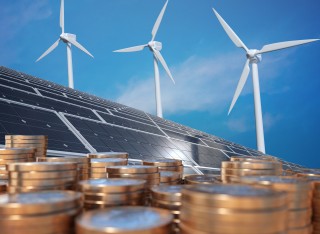
About
Biography
Andrew is an economist who specialises in the macroeconomic impacts of a transition to a low carbon economy, monetary and banking systems, and fiscal and monetary policy. His current projects include building a large scale SFC-IO model to investigate macroeconomic, sectoral and financial dynamics in energy transitions, and investigating the potential for monetary and fiscal policies to work together to address longer term economic challenges including the transition to net zero.
Andrew’s has previously built three stock-flow consistent (SFC) input-output (IO) models to investigate the economic effects of: i) a reduction in energy return on energy invested (EROI) during a net zero transition; ii) a variety of potential shocks associated with a net zero transition, including carbon taxes, divestment campaigns, changes in consumer preferences, and changes in credit conditions; and iii) the interactions between financial transition risks, green investment and reductions in EROI during different net zero transitions. He has also worked on building an agent based SFC model which was used to investigate stranded assets and transition risks. Outside of building macroeconomic models, Andrew has also published papers on EROI and fiscal and monetary cooperation.
Andrew is currently a co-investigator on the EU Horizon funded project Models, Assessment and Policies for Sustainability (MAPS). He was previously a co-investigator on the ESRC funded Rebuilding Macroeconomics project ‘Modelling transition risk: developing an agent-based, stock-flow consistent, input-output macroeconomic framework’
Prior to completing his PhD and starting work at CUSP, Andrew spent several years working as Head of Research for a think tank that specialises in research into monetary and banking systems. During this period he authored several research papers and co-authored two books: “Where does money come from? A guide to the UK banking system”, and “Modernising Money. Why our monetary system is broken and how it can be fixed”. Andrew also has a degree in economics and a master’s degree in development economics, both from the University of Sussex.
Publications
Extracting, processing, and delivering energy requires energy itself, which reduces the net energy available to society and yields considerable socioeconomic implications. Yet, most mitigation pathways and transition models overlook net energy feedbacks, specifically related to the decline in the quality of fossil fuel deposits, as well as energy requirements of the energy transition. Here, we summarize our position across 8 key points that converge to form a prevailing understanding regarding EROI (Energy Return on Investment), identify areas of investigation for the Net Energy Analysis community, discuss the consequences of net energy in the context of the energy transition, and underline the issues of disregarding it. Particularly, we argue that reductions in net energy can hinder the transition if demand-side measures are not implemented and adopted to limit energy consumption. We also point out the risks posed for the energy transition in the Global South, which, while being the least responsible for climate change, may be amongst the most impacted by both the climate crisis and net energy contraction. Last, we present practical avenues to consider net energy in mitigation pathways and Integrated Assessment Models (IAMs), emphasizing the necessity of fostering collaborative efforts among our different research communities.
A number of papers in the field of net energy analysis have argued that declines in energy return on investment (EROI) could lead to increasing energy prices and a fall in economic growth. This paper develops a model (TranSim) which can simulate the economic and financial implications of an energy technology transition involving a reduction in EROI, by combining the stock-flow consistent (SFC) approach with an input-output (IO) model. The TranSim model has the following key features. First, it includes three firm sectors, that produce energy, capital, and other (non-energy, non-capital) goods. Second, an IO model and an Almost Ideal Demand System are integrated into the SFC model. Third, capital vintages have embedded levels of labour productivity and intermediate good requirements that depend on the economic conditions in the period the vintage was produced. Simulations are characterised by an initial increase in output (due to higher investment), followed by periods of recession and below trend growth (due to price inflation and changes to the functional income distribution). The negative effects associated with the transition – recession, stagnation, stagflation, increasing inequality and asset stranding – are positively related to the capital intensity of green energy production and reductions in EROI.
